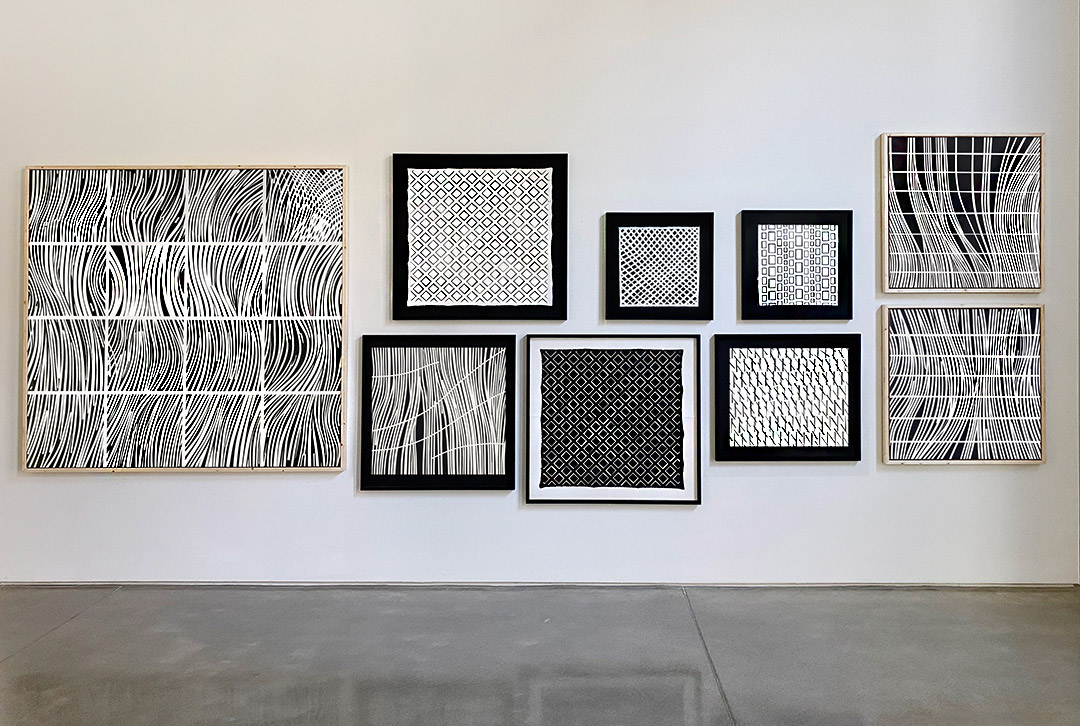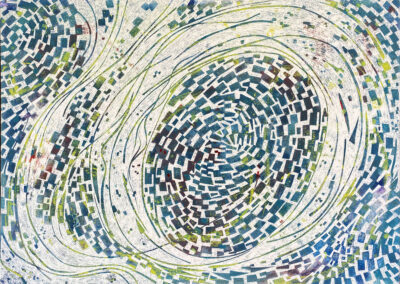Luca Lazar
“Mantras in the Garden”
May – June, 2023
68 Razmadze Street
Luca Lazar’s show Mantras in the Garden presents the expressive abstraction of shapes; small-scale geometrized and minimalist compositions that are constructed with the use of predominantly similar elements. As is already clear from the exhibition title, a wide range of parallels, associations, and allusions are unfolded in front of the audience. Here, the first clear line is directed towards Oriental cultures, emphasizing this fact in a self-evident and obvious way with the use of mantras. However, it is also important not to forget the significance of the “garden” as an independent notion in European consciousness. Taking into consideration that the artist himself is a representative of this field of creative thought, the relevance of the mentioned elements increases even more. This is demonstrated in Luca Lazar’s artistic and stylistic characteristics at any stage of his creative career, and is manifest in all the trends that have ever appeared in his works – whether abstractionism, abstract expressionism, conceptualism, minimalism, or any other art movement. When discussing a garden, a contemporary individual primarily imagines the artificial imitation of a natural landscape. Following the visualization of the artistic taste of the epoch, this has creatively interpreted the spatial environment, possesses a contemporary aesthetic climate, and in addition clearly presents micro-models of the current worldview. It is a trivial fact that at a certain stage of human development, someone who once lived in the natural landscape began to transform and construct his own living environment, creating small–scale cultural habitats and gardens. Obviously, nowadays no one is of the opinion that a garden is just a simple composition built around geometric areas, where the main objective is to create a feeling of authentic landscape and nothing more. However, even an analysis of events and the surface layer reveals numerous associative parallels that are typical of Luca Lazar’s work.
The notion of arranging a garden in European and Oriental cultural areas is connected with attempts to produce an earthly model of the ideal world. Naturally, we first think of the Garden of Eden – a model of paradise, which is built based on understandable and manageable categories of thought. This is a place where the harmonious relationship between humans and nature is given priority; even though unlike the original Garden of Eden, all other gardens where the notion of controlling nature (even if imperceptibly) became the main determinant of the concept, were conceived and constructed by descendants of Adam. The topic of the garden, as a classic example of the ambivalent hybridization of nature and culture, is inseparably linked to European culture.
The garden offers a complex, constantly transforming environment for intellectual exploration, and is distinguished by a highly subjective perceptual context. If we discuss existing art categories, it is easy to imagine that the garden unites a spectrum of modifications, where the medium is nature itself and a human plays the role of author of an artistic work. This is a rare case where nature is perhaps most “artificial,” precisely because it is “real”. At first glance, this is an unusual and bold statement; however, the fact is that similar to any independent artistic work, the garden has for centuries reflected and embodied worldview principles that are determined by its contemporary epoch.
Here one should note the specific design of the exposition offered by the artist. At the show, works of varying sizes are arranged in a mosaic-like, kaleidoscopic fashion from floor to ceiling. The artist rejects the classical principles of an exhibition, covering the walls with canvases. Obviously, the design violates all rules of symmetry, since the various-sized works induce modeling of the walls into mutually adapted sections in a bold visual transformation of the space. The exposition extends the suggested field of thought, which goes beyond the traditional presentation of easel/monumental canvases in the exhibition hall, turning it into an artistic piece of itself and therefore a corresponding expressive component. Each individual work becomes a most essential element of this single great space, which itself acquires an independent artistic significance as an organic and at the same time necessarily defining part of other new, larger artistic units. In this way, the most difficult and sophisticated creative act of transforming an image into an installation takes place in front of the audience.
The show also involves illusory imagination, which adds even more layers to the interpretation. Even though the works were not created as single series and were produced at various times, they are still marked by the artist’s distinct signature and visual style: prerequisites for a successful installation. Luca Lazar possesses a clear sense of rhythm – the most musical element of painting. He does not reduce this to being the sole means of expression, but positions it as the main one. The rhythm of his works differs each time, with a focus on the amplitude of its vibration, ranging from a point to a line. Not only the current exposition, but the artist’s entire previous oeuvre permits the given rhythm in the frames of one work to be characterized as something uniform and symmetrical. It is less focused on contrasts. In the case of the mentioned installation, the contrast of simultaneously separate and differing rhythms conjures a feeling of variety and diversity in the garden that has become a reflection of contemporaneousness. Here one also recalls the recitative sound of the mantra; or more precisely the distant allusions of mantras as ancient knowledge of the relationship between thought and word, shape and name.
Tamar Belashvili














